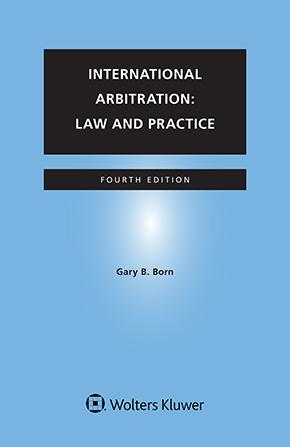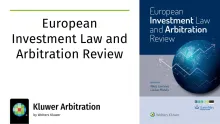International Arbitration and the Rule of Law: Are We at the Crossroads?
August 8, 2025
The rule of law is a hot topic around the world, with threats from reduced access to justice to increased political pressure affecting courts, parties, legal practitioners, and academics in various jurisdictions. How can international arbitration act as a bulwark to protect and promote the rule of law and access to justice? On 24 June 2025, the SCC Arbitration Institute (“SCC”) and the Institute for Transnational Arbitration (“ITA”) co-organized a webinar to consider this very question. The discussion focused on key themes including the rule of law and access to justice in arbitration.
The webinar, supported by the Swedish branch of the International Law Association ("ILA"), featured panelists Barton Legum (Partner, Honlet Legum, Member of the ITA Executive Committee, Member of the SCC Board), Caroline Falconer (Secretary General, SCC), Charles “Chip” Brower (Chair of the ITA), and Federico Ortino (Co-Director of the Centre for International Governance and Dispute Resolution, King’s College London), and moderated by Crina Baltag (Associate Professor, Queen Mary University of London, Member of the ITA Executive Committee, Member of the SCC Board). This post reports on the discussion, before offering some concluding remarks.
Arbitration and the Rule of Law
At the outset of the webinar, Falconer framed the discussion around three foundational principles: access to justice, the rule of law, and independence. She underlines that the SCC embraces these values as part of its core mandate, offering a neutral forum to parties around the world.
Arbitration plays a significant role in upholding key aspects of the rule of law by ensuring impartiality of arbitrators, equal treatment of the parties, and enforceability of arbitral awards. However, its capacity to promote the rule of law is not without limitations. As Brower emphasized, the ultimate responsibility for safeguarding the rule of law lies with States. Quoting Lord Bingham, he noted:
“The core of the existing principle is that [. . .] all persons and authorities within the state, whether public or private, should be bound by and entitled to the benefit of laws publicly and prospectively promulgated and publicly administered in the courts.”
According to this definition, while arbitral institutions and professional organizations can contribute to the advancement and implementation of these values, their role remains secondary to that of States.
Brower further observed that arbitration may not always be the optimal mechanism for advancing certain aspects of the rule of law. For example, appellate review can play a vital role in a dispute. Nevertheless, arbitration continues to stand out as the most relevant, resilient, and trusted method for resolving complex commercial and investment disputes.
Before initiating the panel discussion, Baltag drew attention to the former Secretary-General of the United Nations, Kofi Annan’s definition of the rule of law. Among the key components of this definition are accountability, publicly promulgated laws, equal enforcement, independent adjudication, and consistency with international human rights. The rule of law is thus fundamental to justice and the peaceful resolution of disputes. Baltag noted that “justice” in this context should primarily be understood through the lens of formal justice, rather than substantive justice. Access to justice is a cornerstone of the rule of law and can only be preserved where formal justice is present.
Access to Justice
During the webinar, the panel explored three critical dimensions of access to justice in arbitration: i) the cost of arbitration, ii) the duration of proceedings, and iii) access to the jurisdiction of the arbitral tribunal.
Costs of arbitration
Costs are frequently at the centre of discussions on access to justice. As Baltag noted, concerns around the affordability and predictability of dispute resolution have long been addressed in national legal reforms. For example in the UK, Lord Woolf’s reforms and Lord Justice Jackson’s review emphasized the need to control litigation costs as a key component of access to justice.
Cost effectiveness is equally relevant in the context of international arbitration. As Baltag pointed out, it is critical to maintaining access to justice in arbitration. It is also important to note that the issue of cost is not limited to the quantum or proportionality of fees. It also involves the use of procedural tools that may increase the costs while decreasing accessibility.
In this regard, the predictability of costs at the early stages of a dispute becomes especially important. Falconer highlighted the clarity of the SCC’s cost regime under its arbitration rules, noting that the cost calculator is among the most frequently visited pages on the SCC’s website.
To make dispute resolution more accessible, the SCC continues to develop innovative and cost-effective services. These include the SCC Expedited Arbitration Rules, SCC Mediation, and SCC Express, among others. Additionally, the SCC Arbitration Rules contain provisions designed to save the parties time and costs. For example, Article 38 expressly allows respondents to request security for costs, which can provide further clarity and balance in managing financial risk during proceedings.
Duration of arbitration
Arbitration is often much faster than litigation before national courts. Legum emphasized that the absence of a formal appeals process contributes to this speed and arbitral awards can only be annulled on limited grounds.
As Falconer observed, in dispute resolution, “time is money.” The longer the proceedings, the higher the associated costs. However, this is largely due to the costs of legal representation. As the SCC’s Report on the Costs of Arbitration and Apportionment of Costs reveals, on average less than 8% of the total costs relates to the arbitrators’ fees and the administrative fees in arbitration conducted under the SCC Rules.
To manage duration and costs effectively, parties can choose the most suitable procedural path. For example, in 2024, 92% of cases administered under the SCC Expedited Arbitration Rules were resolved within six months. This is firmly in line with Legum’s observation on the SCC’s “culture of speed.”
Additionally, the SCC Arbitration Rules offer a summary procedure under Article 39, allowing the arbitral tribunal to resolve specific issues of fact or law without undertaking all procedural steps typically required in full proceedings. This tool provides flexibility and expedience, particularly where the dispute concerns narrow or clearly defined matters.
As Baltag recalled, “justice delayed is justice denied.” However, arbitral institutions clearly offer parties a variety of tools to resolve their disputes efficiently. Where traditional arbitration may appear too slow or costly, there are alternative methods offering valuable alternatives.
Access to the jurisdiction of the arbitral tribunal
The jurisdiction of the arbitral tribunal is crucial to ensuring substantive justice and upholding the rule of law, as highlighted by Baltag. The panel discussed the recent RFC Seraing v. FIFA case, which underscores tensions between supranational arbitral authority and EU and national laws.
The dispute began when FIFA sanctioned Seraing for engaging in banned third-party ownership agreements. The club challenged FIFA’s decision before the Court of Arbitration for Sport (“CAS”), which upheld FIFA’s rules. The Swiss Federal Tribunal later upheld the award. Seraing sought review in Belgian courts, arguing the arbitration clause violated their right of access to courts under Belgian and EU law, and that enforcement would violate public policy. However, the Belgian courts dismissed the claim, citing res judicata.
Subsequently, CAS accepted a further review request by Seraing and referred the matter to the Court of Justice of the European Union (“CJEU”). As explained by Ortino, in the Opinion of the Advocate General, Seraing should have a direct judicial path to assess whether FIFA’s rules and the CAS award comply with EU law. Importantly, the Advocate General distinguished CAS arbitration from commercial arbitration by noting that: i) CAS arbitration is mandatory, and ii) CAS awards are self-enforcing, and thus the New York Convention is not applicable (see Blog posts here and here).
Ortino concluded that this reasoning attempts to differentiate between types of arbitration, similar to the distinction between commercial and investment arbitration. The CJEU’s final decision is pending, but at its core, the case raises questions about access to the tribunal’s jurisdiction.
Legal Certainty and Neutrality
The second part of the webinar focused on the legitimacy of arbitration, particularly in investor-State dispute settlement (“ISDS”). Baltag highlighted that arbitration is often preferred in ISDS because it is free from political interference. Investors frequently distrust domestic courts believing that they will not be guaranteed a fair trial, making ISDS a fairer forum for resolving such disputes. As Legum pointed out, ISDS is not a perfect system. However, it is the best available option.
Falconer highlighted the crucial role of arbitral institutions in ISDS, emphasizing the need for transparency to increase legal certainty and neutrality. While confidentiality is maintained, transparency in procedure is crucial to building trust. She pointed to the SCC’s ongoing efforts to increase transparency, including regular reports such as Arbitrating for Peace: Stockholm, SCC Arbitration Institute, and ISDS.
Conclusion
Returning to the headline question on the crossroads between international arbitration and the rule of law, the discussion confirmed that both international arbitration and the rule of law form an important intersection. Arbitration cannot exist without the rule of law, while also acting to support the rule of law. But both are at their own crossroads, given recent developments and ongoing debates around the world. Arbitration may not be flawless, however, it remains an important and legitimising mechanism, in the absence of a better alternative. Moreover, when the right tools and procedures are employed, it can offer a cost-effective and efficient path to access justice. Arbitral institutions like the SCC demonstrate this through modern, transparent practices and accessible services.
You may also like











